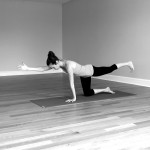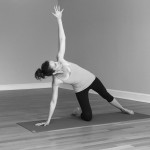Navigating core work during pregnancy is as confusing as determining which seafood is safe to eat. There are so many rules and restrictions that on the one hand it’s tempting to toss your arms up and forge t the whole thing. On the other hand, it may be tempting to continue with your standard core strengthening routine without properly modifying. Do neither of these things.
t the whole thing. On the other hand, it may be tempting to continue with your standard core strengthening routine without properly modifying. Do neither of these things.
I’m all for pregnant women staying fit and strong and being their badass selves, but no one wins if you don’t modify your ab exercises. Don’t get me wrong. A strong core benefits a woman from the 1st trimester into her postnatal body. With those muscles in working shape you can avoid many of the pains of pregnancy especially in the back which becomes more vulnerable as your belly gets progressively bigger. You will also bounce back to your pre-pregnancy shape faster. Yes, I know we need to be content with our new bodies but honestly wouldn’t we prefer to have some elements of the former one. Therefore, it’s important to understand which muscles we can continue to strengthen and which ones need a break.
A strong girdle around the baby provides support to hold the extra weight. The transversus abdominis (the deep abdominals) and the back muscles make up this support system for the belly. Developing these muscles before and during pregnancy reduce back pain and ease labor. The rectus abdominis (the muscles that create 6-pack abs) are the ones we want to leave alone. When we focus on these surface muscles we risk causing diastasis recti, which is harder to solve than to prevent. Diastasis recti occurs when the abdominal muscles spread apart resulting in a saggy tummy. Ironically, overworking the rectus abdominis leads to this unintended effect because when these muscles are overly taut the belly forces its way through them making a wider separation. It can be fixed, but if it can be avoided…
The illustration below depicts the shifting muscles in the changing body, as well as emphasizes (irrelevantly I might add) the changing breasts. Way to rub it in… It does offer a nice visualization of how the muscles rearrange pre, during, and post pregnancy.
What else are we worried about:
1. Breathing: I want you to breath. It’s critical. Many abdominal exercises involve lying on your back, which puts pressure on the vena cava and thus slows blood flow to the baby and to your heart.
2. Diastasis Recti. I already mentioned this above – stay away from traditional sit-ups and crunches.
3. Body image. We have to let go a little bit of maintaining our previous figure. Staying fit, healthy, and strong is important. Putting pressure on ourselves to maintain 6 pack abs is an added, unnecessary burden when you already have some big life changes.
So what can you do?
In the 1st trimester, you are (with the okay of your doctor) safe to continue with standard abdominal work.
Once you are in the 2nd trimester, modifications become necessary. The following poses offer safe, challenging exercises to strengthen the core.
- Bird Dog: Come to all fours on mat with shoulders over wrists, knees hip-width apart and spine neutral. Extend left arm forward and right leg back. Take 5 breaths and then switch sides.

Bird Dog
- Forearm Plank: You can modify by coming to your knees or coming to a high plank.
- Side Plank: Extend the top leg and bring bottom knee to mat.
-

Modified Side Plank
- Modified Navasana: Keep your forearms on mat behind you. With bent knees lift legs to tabletop so your calves are parallel to mat. alternate lowering one foot and tapping toes to mat and bringing it back up to tabletop and lowering other foot.

Modified Navasana

